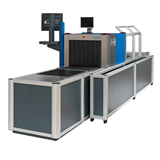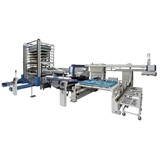But there’s one name every taxi drivers knows in Saigon: “ARRR – MITT”, that is R.M.I.T. - The Royal Melbourne Institute of Technology University - which is making quite a splash since setting up in South Saigon in 2001.
According to RMIT’s President and Pro Vice Chancellor in Ho Chi Minh City, Professor Merilyn Liddell, RMIT’s involvement in Vietnam started in 1990s, with the campus proper beginning in 2001.
She said it was quite something for the Vietnamese Government to do for a foreign institution: “The Vietnamese Government put through special legislation to allow us to set up. It was a big thing for them to allow a foreign university to set up a campus within its national borders. And they have been supportive ever since as has the Australian Government in terms of advice, problem solving and trouble-shooting along the way. It’s been a relatively smooth ride for us but it’s not without its challenges along the way.”
RMIT offers degrees in their tradition areas of comparative advantage such as: business and IT, accounting, business information systems, media and communications. RMIT, after all, was originally known as “The Working Man’s College” when it was first set up in Melbourne, and has always had reputation for offering practical courses with strong application to industry. This tradition has continued in Vietnam.
According to Professor Liddell: “Eventually I’d like to expand into RMIT’s traditional strengths in engineering but produce ‘business ready’ engineers by combining technical skills with teamwork, creative skills, problem solving and other strengths that Australian engineering schools typically provide.”
Professor Liddle also wants to increase the depth of academic staff at RMIT Saigon. “Many academics come here for idealistic reasons – they want to help a developing country and clearly they have an affinity with Vietnam – but I want to grow the pool of human capital – both international and local – to build up the research capability as well as the teaching resources.
RMIT also hopes to expand its courses over the next decade. By the year 2020, RMIT hopes to eventually add areas like biotechnology and health sciences to the offering they provide as those areas will be important to Vietnam as the economy develops and the Vietnamese population become more affluent.
In fact, RMIT’s involvement in Vietnam is symbolic of Australia’s economic engagement with the country. In a recent visit to Vietnam, Australia’s Trade Minister Simon Crean, nominated education as one of Australia’s key industry sectors to further develop Australia’s economic engagement with Vietnam.
In a recent speech in Vietnam, Crean nominated education, along with Infrastructure and Environmental Management, energy, oil and gas, agribusiness and financial services. In the speech the Trade Minister spoke of the Crean family’s strong ties to the country.
“In 1973, the Whitlam Government recognised Vietnam and established diplomatic ties. This happened when my father, Frank Crean, was Deputy Prime Minister,” he said.
Simon Crean himself also visited Vietnam in 1995, when he was Minister for Education, Employment and Training in the Keating Government to sign Memorandum of Understanding on education services before returning this year as Trade Minister.
Education and infrastructure are very important to Vietnam’s economic development as the emerging Asian ‘Tiger’ economy wants to avoid capacity constraints on the supply side that have adversely affected other nations in South East Asia.
According to Ray Mallon, an Australian economist based in Hanoi, who is a long-term Vietnam analyst, Vietnam may avoid the ‘Bright Lights, Big City’ problem in other developing economists (made famous by the Harris-Todaro model in economic literature) by building up the coastal regions along the Eastern Seaboard.
“If Vietnam just concentrates on Hanoi and Ho Chi Minh City for all its development it will face major infrastructure hurdles. But if it can divert some of its resources to building coastal highways and developing the regional growth centres then it will avoid a lot of pitfalls that have affected other South East Asian countries that in part, contributed to their financial troubles in 1997-98.”
Of course the expansion of education and infrastructure presents major challenges to the Vietnamese financial system too, that has felt the pressure of the very strong growth that Vietnam experienced in the lead-up to WTO accession.
World Bank Lead Economist for Vietnam, Martin Rama explained that Vietnam “experienced huge capital inflow in 2007 of around US$ 17 billion (A$20.5 billion), without the capacity for monetary sterilization or an exchange rate adjustment. This caused some overheating, even before the impact of the global financial crisis.”
Asian Development Bank Economist Bahodir Ganiev also believes that Vietnam’s financial system is affected “by the ability of state owned enterprises to inject cash into the system putting further pressure on macroeconomic policy. This created turbulence even though the long term demographic and income trends are still in Vietnam’s favour.”
Australia’s Ambassador to Vietnam, Allaster Cox, believes there are opportunities from the development of Vietnam’s financial system. “We’ve seen interest from Australian financial services specialists in Vietnam for some time, with ANZ and Commonwealth Bank leading the charge.”
In fact, there are strong links between financial services and education. According to Ms Do Ha, a high flying young Vietnamese executive with the Commonwealth Bank in Ho Chi Minh City the demographics and expansion of education in Vietnam are helping business prospects for the Bank.
According to the Monash University-educated, Ms Ha, the older generation would never borrow, were never able to buy property and too poor to receive an education.
“The new generation of Vietnamese, want an education and are willing to finance it. That’s why the Commonwealth Bank works closely with the education institutions to attract student customers. We know if we can help them as students in Australia, they’ll stick with us as retail customers when they return home to Vietnam. We really want to build on our reputation as ‘The People’s Bank’ in both Australia and Vietnam.”
What’s driving this growth for Australian financial services exporters is the fact that the capacity to invest in education is very strong in Vietnam. According to Shannon Leahy of Austrade Ho Chi Minh City, “10 per cent of the Vietnamese population of 87 million have bank accounts Vietnamese people, from the poor to the middle class and the elites, have a high propensity to spend their income on education at around 10 per cent, even for poor and middle class families.”
It’s no wonder that the Saigon taxi drivers know where RMIT is, and given the expansion of education in Vietnam, and the aspirations of the Vietnamese to invest in education, many more will be finding their way to RMIT Saigon, and we really will see an education revolution that Ho Chi Minh could only dream about.
- Suppliers
- New to IndustrySearch? Book a Demo
- Advertise with us
- Login
- Email Marketing
- Buyers
- Get Quotes
- Articles & Ideas
- Login
- Subscribe to newsletter
- My Details
- Get Quotes
- Automation & Control
- Automotive Workshop Equipment
- Cleaning Equipment
- Construction & Heavy Machinery
- Conveyor Systems & Components
- Cranes & Hoists
- Electrical & Power Generation Equipment
- Electronic Components
- Farming & Agriculture
- Food & Beverage Processing
- Forklifts & Attachments
- Hydraulic & Pneumatic Equipment
- Industrial Materials, Tools & Components
- Industrial Pumps
- IT Hardware & Industrial Computing
- IT Software & Applications
- Laboratory Equipment & Instruments
- Manufacturing & Industrial Equipment
- Material Handling & Lifting
- Metalworking & Machining
- Mining Equipment & Machinery
- Packaging & Labelling Machinery
- Pallet Management
- Personal Protective Equipment
- Security & Surveillance
- Test & Measurement
- Transport Equipment
- Trucks & Trailers
- Warehouse Storage & Racking
- Waste & Environmental Management
- Welding Machines & Accessories
- Woodworking & Joinery Machines
- Workplace Equipment
- Workplace Safety Equipment
- Get Quotes
- Automation & Control
- Automotive Workshop Equipment
- Cleaning Equipment
- Construction & Heavy Machinery
- Conveyor Systems & Components
- Cranes & Hoists
- Electrical & Power Generation Equipment
- Electronic Components
- Farming & Agriculture
- Food & Beverage Processing
- Forklifts & Attachments
- Hydraulic & Pneumatic Equipment
- Industrial Materials, Tools & Components
- Industrial Pumps
- IT Hardware & Industrial Computing
- IT Software & Applications
- Laboratory Equipment & Instruments
- Manufacturing & Industrial Equipment
- Material Handling & Lifting
- Metalworking & Machining
- Mining Equipment & Machinery
- Packaging & Labelling Machinery
- Pallet Management
- Personal Protective Equipment
- Security & Surveillance
- Test & Measurement
- Transport Equipment
- Trucks & Trailers
- Warehouse Storage & Racking
- Waste & Environmental Management
- Welding Machines & Accessories
- Woodworking & Joinery Machines
- Workplace Equipment
- Workplace Safety Equipment
Trusted by 1.2 million Australian industrial buyers
Buyers
- Discover products & solutions
- Login
- Subscribe To Newsletter
- Browse All Products
- Read Articles
Suppliers
Advertise
- Promote your products & solutions
- New to IndustrySearch? Book a Demo
- Login / Forgot Password
- Advertise Your Products
- Success Stories
- Email Marketing
- Suppliers
- Advertise with us
- Login
- Email Marketing
- Buyers
- Get Quotes
- Articles & Ideas
- Login
- Subscribe to newsletter
- My Details
Get Quotes
- Automation & Control
- Automotive Workshop Equipment
- Cleaning Equipment
- Construction & Heavy Machinery
- Conveyor Systems & Components
- Cranes & Hoists
- Electrical & Power Generation Equipment
- Electronic Components
- Farming & Agriculture
- Food & Beverage Processing
- Forklifts & Attachments
- Hydraulic & Pneumatic Equipment
- Industrial Materials, Tools & Components
- Industrial Pumps
- IT Hardware & Industrial Computing
- IT Software & Applications
- Laboratory Equipment & Instruments
- Manufacturing & Industrial Equipment
- Material Handling & Lifting
- Metalworking & Machining
- Mining Equipment & Machinery
- Packaging & Labelling Machinery
- Pallet Management
- Personal Protective Equipment
- Security & Surveillance
- Test & Measurement
- Transport Equipment
- Trucks & Trailers
- Warehouse Storage & Racking
- Waste & Environmental Management
- Welding Machines & Accessories
- Woodworking & Joinery Machines
- Workplace Equipment
- Workplace Safety Equipment
Get Quotes
- Automation & Control
- Automotive Workshop Equipment
- Cleaning Equipment
- Construction & Heavy Machinery
- Conveyor Systems & Components
- Cranes & Hoists
- Electrical & Power Generation Equipment
- Electronic Components
- Farming & Agriculture
- Food & Beverage Processing
- Forklifts & Attachments
- Hydraulic & Pneumatic Equipment
- Industrial Materials, Tools & Components
- Industrial Pumps
- IT Hardware & Industrial Computing
- IT Software & Applications
- Laboratory Equipment & Instruments
- Manufacturing & Industrial Equipment
- Material Handling & Lifting
- Metalworking & Machining
- Mining Equipment & Machinery
- Packaging & Labelling Machinery
- Pallet Management
- Personal Protective Equipment
- Security & Surveillance
- Test & Measurement
- Transport Equipment
- Trucks & Trailers
- Warehouse Storage & Racking
- Waste & Environmental Management
- Welding Machines & Accessories
- Woodworking & Joinery Machines
- Workplace Equipment
- Workplace Safety Equipment
Trusted by 1.2 million Australian industrial buyers



-160x160-state_article-rel-cat.png)

-160x160-state_article-rel-cat.png)








-160x160-state_article-rel-cat.png)



-160x160-state_article-rel-cat.png)
-160x160-state_article-rel-cat.png)






